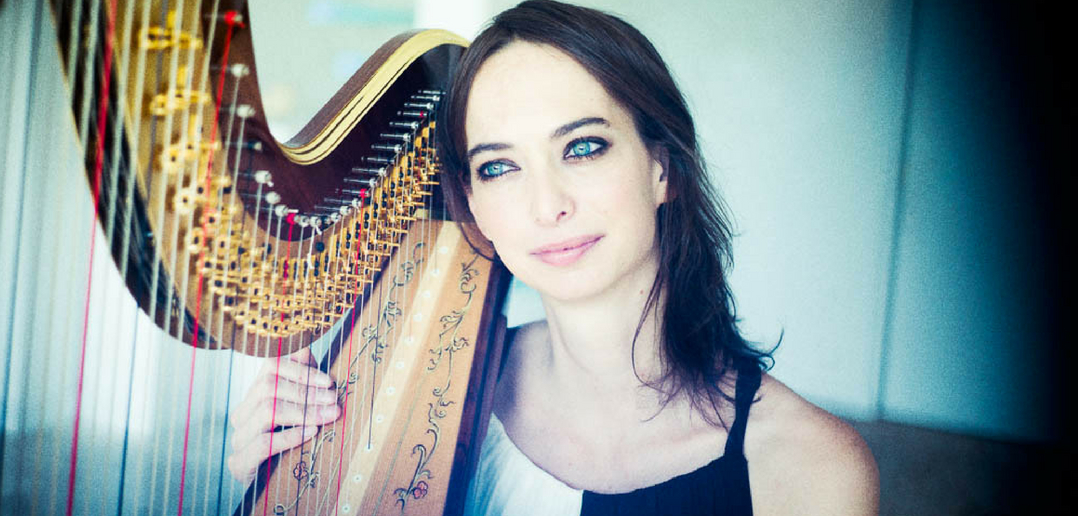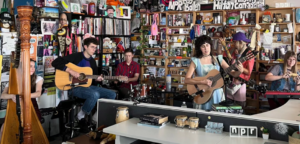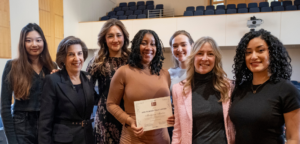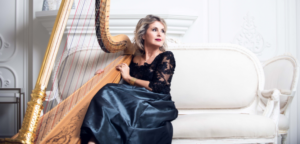Gwyneth Wentink, international harp sensation, has again joined forces with saxophonist George Brooks and violinist Kala Ramnath to create Elements’ second album, The Alchemy, released May 25, 2018. Harp Column caught up with Wentink to learn more about the unique album art, unusual blend of voices, and how she finds balance in her busy schedule.
Congratulations on your latest album. I’d love to know about the cover art. From the fonts and colors chosen to the imagery, it really stands out. How did you decide on your album cover?
The cover art for The Alchemy is a painting by artist/designer Deb McCarroll. The 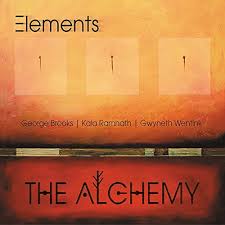 first Elements CD cover is also a McCarroll painting and the Elements font is her design. We feel that the abstract nature of the paintings offers the viewer an opportunity to explore without dictating a particular set of emotions. In many ways, this is analogous to our music. It kind of moves from abstraction and literalism. There are of course the three elements which refer to the three instruments and backgrounds. And the golden glow suits the Alchemy!
first Elements CD cover is also a McCarroll painting and the Elements font is her design. We feel that the abstract nature of the paintings offers the viewer an opportunity to explore without dictating a particular set of emotions. In many ways, this is analogous to our music. It kind of moves from abstraction and literalism. There are of course the three elements which refer to the three instruments and backgrounds. And the golden glow suits the Alchemy!
I’d love to know more about your trio name and album title. Alchemy, elements… the album was even produced by Earth Brother Music! It feels like you have a very singular idea that you are trying to convey.
Well, that’s not entirely true! Earth Brother Music is George Brook’s record company, and although I agree it goes well together with the Alchemy and Elements, you can explain the name on various levels. In the first place, it’s a little play on George’s name. The first three letters of George’s name, Geo, translate to Earth and the Bro of Brooks is slang for brother. George is a bit of an urban farmer. He has a beautiful garden, and is in the mud and dirt when he’s not practicing or writing music! Actually, he has a serene practice studio in this garden – so inspiring. George has been involved with global musical collaborations since the 1970s, so the name also speaks to that sense of global community and connection.
The name Elements refers to the multiple threads of music we weave together. We unite the essential “elements” of Western classical, Indian classical, and western improvised (jazz) music. We also represent three approaches to sound production: bowing, blowing, and plucking. The Alchemy was inspired by the writings of Hazrat Inayat Khan, a musician and teacher whom introduced sufism and Indian classical to the west. Khan lived in Paris and London in the 1920s and served as inspiration to composers and theologists. His book, The Alchemy of Happiness, speaks of the idea of transformation, and we believe that music is a transformational entity, spiritual, personal….
Your trio is described as “global chamber jazz.” I would guess that many harpists know you for winning first prize in the 1998 International Harp Contest in Israel, so this collaboration is obviously in a very different vein of music-making. Can you tell me how the three of you connected to create this genre-fusion?
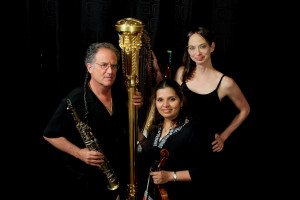
I’ve been traveling to India since I was about 18, not too long after my Israel time. I’ve always been fascinated by Indian music. After finishing conservatory, I studied music therapy for a year, and at 19 I was awarded the Dutch Music Prize. This enabled me to expand my horizons and undertake new musical adventures. I wanted to immerse myself in Indian music, and was therefore introduced to the Indian bansuri legend Pandit Hariprasad Chaurasia. He invited me for a concert in New York and mentioned on the plane that he also invited a saxophone player from California. This was George! George has been active in Indian music since the 1970s and I would say he is at least half-Indian, ha! Besides his career in jazz where he played with artists like Etta James, Larry Coryell, and Terry Riley, he has had extensive study in Indian classical music. George has been a mainstay in the Indian “fusion” realm and was introduced to Kala Ramnath through their mutual work with Zakir Hussain.
One day, I think this was in 2013, I was in Mumbai rehearsing with George at the Gurukul (school) of Pt Hariprasad Chaurasia. George had wanted to introduce me to Kala and invited her to the rehearsal. At the meeting we played together and felt an immediate musical and personal rapport. We realized there was wonderful potential in this unique combination of musicians and instruments.
Both George Brooks, the saxophone player in your trio, and Kala Ramnath, Element’s violinist, compose music for the ensemble. What is your involvement with crafting the music? Do you collaborate with them to create the harp part?
Absolutely. Indian music is, generally speaking, improvisation based. In a classical north Indian performance, there is very little composed material. The performance relies on improvisation within a specified raga (mode) and rhythmic cycle. With a small theme which might be decided upon beforehand, the artists create an entire evening of music. Prior to the formation of Elements, George and I worked frequently with Hariprasad Chaurasia. For these performances, George would compose patterns based on the ragas and rhythmic cycles. I would take these patterns as a starting point and develop them through improvisation. My work playing continuo with the English Baroque Soloists has added a new dimension to my sense of improvisation. Perhaps surprisingly, in Baroque music and in jazz the “rhythm section” players are given a set of “chord changes” and have rely on their improvisational instincts and understanding of the language of the music to develop their own parts.
That brings me to my next question: playing without music. You released a video of your first track, “To the Light,” last year, and it’s incredibly compelling. One thing that really stuck out to me is that all three of you played your parts without music. Is that typical for Elements? How much is improvised?
We try to memorize as much as possible and create a context in which we can be in the moment and draw on inspiration.
Well, when I say we, I mostly mean me, as I perform the largest quantity of composed material and much of what I play provides the structural support for the compositions. Indian music is, in general, aural music. Kala doesn’t really read from notation, and hence has developed an extraordinary musical memory and improvisational abilities. George takes the middle road moving between improvisation and composed material.
My contribution has the most ‘fixed’ parts, but we like to maintain the flexibility as a group to make significant, spontaneous changes on stage. Although it was an adjustment for me in the beginning, it’s now something I really love. It gives so much freedom and really keeps us aware of what we are creating together.
You are currently touring with the Orchestra Revolutionaire et Romantique and the English Baroque Soloists, and I know you are very active as an arts advocate and executive. It is clear that you stay incredibly busy – how do you find balance?
I love the versatility of the things I do, and I agree it can be busy sometimes! Traveling, being in different countries and climates does ask a lot of me on many levels. I have a daily yoga and meditation practice in the morning which I stick to while traveling. I like running and sports in general, so I make time for that. I do the obvious things to keep my body and spirit healthy: exercise, attention to food, and spending time with the people I love even while traveling. As many sides of the touring life can be extreme, I like to practice “everything in moderation… even moderation” to keep me balanced.
Anything else you’d like Harp Column readers to know?
We live in a time where many exciting collaborations take place and I see this reflected in the harp world today as well. The harp can play so many roles in the arts scene and I hope harpists are not afraid to experiment and explore new routes. You might know where you end up but experimenting and just jumping in the deep end can be such a rewarding move, especially if you are inspired to move in that direction. Take the leap! This may not be the path to instant commercial success, but I believe taking the risk will always pay itself back.
To purchase the album from various streaming platforms, click here. Subscribe today to read more about Wentink in Harp Column’s March-April 2000 issue or visit her website at http://gwynethwentink.com/.





